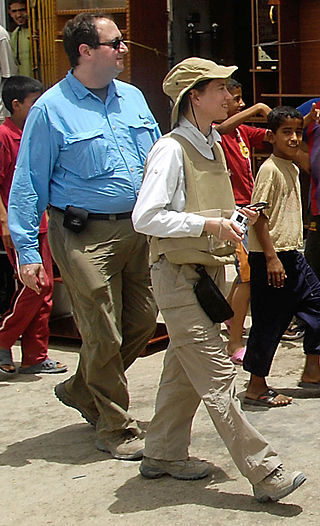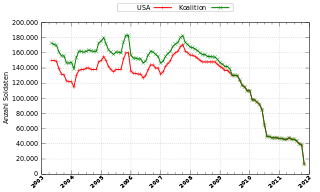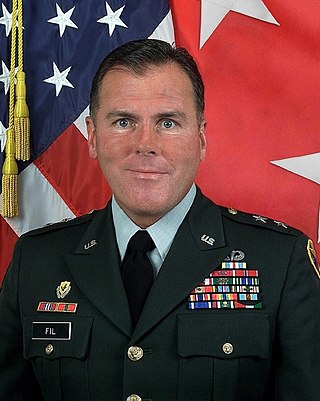
The 1st Armored Division, nicknamed "Old Ironsides", is a combined arms division of the United States Army. The division is part of III Armored Corps and operates out of Fort Bliss in El Paso, Texas. It was the first armored division of the United States' Army to see battle in World War II. Since World War II, the division has been involved in the Korean War, Cuban Missile Crisis, Persian Gulf War, Iraq, Afghanistan, and several other operations. The division has also received numerous awards and recognition.

The 1st Infantry Division is a combined arms division of the United States Army, and is the oldest continuously serving division in the Regular Army. It has seen continuous service since its organization in 1917 during World War I. It was officially nicknamed "The Big Red One" after its shoulder patch and is also nicknamed "The Fighting First." The division has also received troop monikers of "The Big Dead One" and "The Bloody First" as puns on the respective officially sanctioned nicknames. It is currently based at Fort Riley, Kansas.

The 4th Infantry Division is a division of the United States Army based at Fort Carson, Colorado. It is composed of a division headquarters battalion, three brigade combat teams, a combat aviation brigade, a division sustainment brigade, and a division artillery.

III Corps is a corps of the United States Army headquartered at Fort Cavazos, Texas. It is a major formation of the United States Army Forces Command.

Frederick W. Kagan is an American resident scholar at the American Enterprise Institute (AEI) and a former professor of military history at the U.S. Military Academy at West Point.

The 28th Infantry Division ("Keystone") is a unit of the Army National Guard and is the oldest division-sized unit in the Department of Defense. Some of the units of the division can trace their lineage to Benjamin Franklin's battalion, The Pennsylvania Associators (1747–1777). The division was officially established in 1879 and was later redesignated as the 28th Division in 1917, after the entry of America into the First World War. It is today part of the Pennsylvania Army National Guard, Maryland Army National Guard, Ohio Army National Guard, and New Jersey Army National Guard.

George William Casey Jr. is a retired four-star general who served as the 36th Chief of Staff of the United States Army from April 10, 2007, to April 10, 2011. He served as Commanding General, Multi-National Force – Iraq from June 2004 to February 8, 2007, and was in the army for his entire adult working life. He now resides in Arlington, Virginia.

David Howell Petraeus is a retired United States Army general and public official. He served as Director of the Central Intelligence Agency from September 6, 2011, until his resignation on November 9, 2012. Prior to his assuming the directorship of the CIA, Petraeus served 37 years in the United States Army. His last assignments in the Army were as commander of the International Security Assistance Force (ISAF) and commander, U.S. Forces – Afghanistan (USFOR-A) from July 4, 2010, to July 18, 2011. His other four-star assignments include serving as the 10th commander, U.S. Central Command (USCENTCOM) from October 13, 2008, to June 30, 2010, and as commanding general, Multi-National Force – Iraq (MNF-I) from February 10, 2007, to September 16, 2008. As commander of MNF-I, Petraeus oversaw all coalition forces in Iraq.

The 9th Cavalry Regiment is a parent cavalry regiment of the United States Army. It is not related to the 9th Kansas Cavalry Regiment of the Union Army. Historically, it was one of the Army's four segregated African-American regiments and was part of what was known as the Buffalo Soldiers. The regiment saw combat during the Indian and Spanish–American Wars. During Westward Expansion, the regiment provided escort for the early western settlers and maintained peace on the American frontier.

Herbert Raymond McMaster is a retired United States Army lieutenant general who served as the 25th United States National Security Advisor from 2017 to 2018. He is also known for his roles in the Gulf War, Operation Enduring Freedom, and Operation Iraqi Freedom.

Thomas Edwin "Tom" Ricks is an American journalist and author who specializes in the military and national security issues. He is a two-time winner of the Pulitzer Prize for National Reporting as part of teams from the Wall Street Journal (2000) and Washington Post (2002). He has reported on military activities in Somalia, Haiti, Korea, Bosnia, Kosovo, Macedonia, Kuwait, Turkey, Afghanistan, and Iraq. He previously wrote a blog for Foreign Policy and is a member of the Center for a New American Security, a defense policy think tank.
Toby Dodge is an English political scientist whose main area of interest lies in the Middle East. He completed a PhD on the transformation of international system in the aftermath of the First World War and the creation of the Iraqi state at the School of Oriental and African Studies, University of London. He also taught international relations and Middle Eastern politics in the Department of Political Studies at SOAS for four years. Toby was Senior Research Fellow at the Centre for the Study of Globalisation and Regionalisation at the University of Warwick. He is currently a Reader in the International Relations department at LSE and Senior Consulting Fellow for the Middle East at the International Institute for Strategic Studies.

The Iraq War troop surge of 2007, commonly known as the troop surge, or simply the surge, refers to the George W. Bush administration's 2007 increase in the number of U.S. military combat troops in Iraq in order to provide security to Baghdad and Al Anbar Governorate.

General William Allen Knowlton was a United States Army four-star general, and a former Superintendent of the United States Military Academy. As a full general, he served as Commander, Allied Land Forces South East Europe, and as the United States Military Representative to the North Atlantic Treaty Organization.

Major General Joseph Frederick Fil Jr. was commissioned a Second Lieutenant in the United States Army in June 1976. He is a Distinguished Military Graduate of San José State University. He has served in Army units in the United States, Germany, Belgium and Iraq.

Peter William Chiarelli is a retired United States Army general who served as the 32nd Vice Chief of Staff of the United States Army from August 4, 2008 to January 31, 2012. He also served as commander, Multi-National Corps – Iraq under General George W. Casey, Jr. He was the Senior Military Assistant to the Secretary of Defense from March 2007 to August 2008. He retired from the United States Army on January 31, 2012 after nearly 40 years of service, and was succeeded as Vice Chief of Staff by General Lloyd J. Austin III.

Steven Arthur Boylan, formerly a U.S. military spokesman in Baghdad for General David Petraeus in the prosecution of the Iraq War troop surge of 2007 from February, 2007 to September, 2008. After leaving Iraq, he became the public affairs officer and the senior public affairs observer/trainer for the Battle Command Training Program (BCTP) at Fort Leavenworth, Kansas, according to U.S. News & World Report.

Douglas Ollivant is a Senior National Security Studies Fellow at the New America Foundation as well as a Managing Partner at Mantid International. Most recently, Ollivant was a senior counterinsurgency (COIN) advisor to Regional Command East, as part of the International Security Assistance Force COIN Advisory and Assistance Team. He served as Director for Iraq on the National Security Council under the Bush and Obama administrations. A retired U.S. Army officer, he has served two tours in the Iraq War, first as the operations officer for the First Battalion, Fifth Cavalry Regiment during OIF II and later as the Chief of Plans for Multi-National Division-Baghdad during the “Surge”, leading the team which wrote the Baghdad Security Plan.
The history of the United States Army began in 1775, as part of the United States Armed Forces. The Army's main responsibility has been in fighting land battles and military occupation. The Corps of Engineers also has a major role in controlling rivers inside the United States. The Continental Army was founded in response to a need for professional soldiers in the American Revolutionary War to fight the invading British Army. Until the 1940s, the Army was relatively small in peacetime. In 1947, the Air Force became completely independent of the Army Air Forces. The Army was under the control of the War Department until 1947, and since then the Defense Department. The U.S. Army fought the Indian Wars of the 1790s, the War of 1812 (1812–15), Mexican–American War (1846-1848), American Civil War (1861–65), American Indian Wars, Spanish–American War (1898), World War I (1917–18), World War II (1941–45), Korean War (1950–53) and Vietnam War (1965–71). Following the Cold War's end in 1991, Army has focused primarily on Western Asia, and also took part in the 1991 Gulf War and war in Iraq, and the war in Afghanistan.

Kimberly Ellen Kagan is an American military historian. She founded and heads the Institute for the Study of War and has taught at West Point, Yale, Georgetown University, and American University. Kagan has published in The Wall Street Journal, The New York Times, The Weekly Standard and elsewhere. In 2009, she served on Afghanistan commander Gen. Stanley McChrystal's strategic assessment team.

















